|
|
|||||
|
|
|||||
|
Counter added Sunday, March 25, 2007 -11:00 am Pacific Time
|
|||||
|
|
|
Sunday, April 1, 2007 - The Masons of Wilshire |
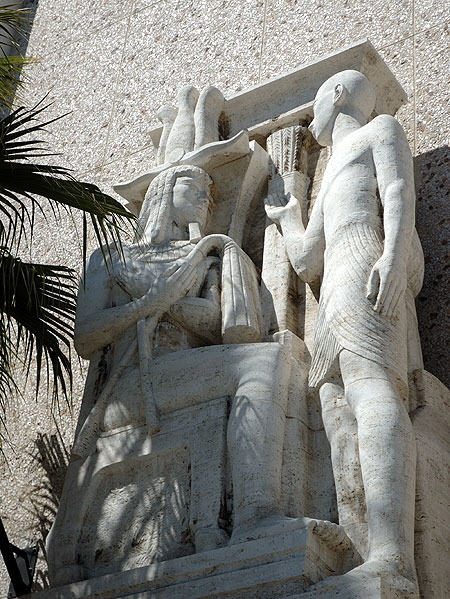 |
|
Many of us only think of the Masons when we think of that young composer. The plot of Mozart's opera Die Zauberflöte ("The Magic Flute") contains several references to Masonic ideals and ceremonies. Mozart and his librettist Emanuel Schikaneder were both members of Lodge of the Nine Muses. It's an eighteen century enlightenment thing. But then out here there's the former Masonic Scottish Rite Temple, designed by the late architect and artist Millard Sheets, 4357 Wilshire Boulevard. If you dig around you find Sheets also painted the murals on LA City Hall - and designed the official seal for the County of Los Angeles, and you can consult this biography. In 1954 Sheets was appointed Director of Otis College of Art and Design (then call Otis Art Institute) and under his leadership they added BFA and MFA degrees. The Library at Otis was named after him in 1997. This building is very odd. So is Freemasonry - Freemasonry is the oldest and largest world wide fraternity dedicated to the Brotherhood of Man under the Fatherhood of a Supreme Being. Although of a religious nature, Freemasonry is not a religion. It urges its members, however, to be faithful and devoted to their own religious beliefs. There's much more at the link, and see what's below the photographs for the Scottish business. See also Famous Freemasons, including presidents Buchanan, Ford, Garfield, Harding, Jackson, McKinley, Monroe, Polk, Roosevelt (Franklin D and Theodore), Taft, Truman, and Washington. But there was Benedict Arnold - and Mark Twain, and Sir Author Conan Doyle, and Ty Cobb and George M. Cohan - and Irving Berlin, Duke Ellington and Count Basie, and Henry Ford and George Wallace. Anyway, Masons use the metaphor of stonemasons' tools and implements, against the allegorical backdrop of the building of King Solomon's Temple, to convey what is generally defined as "a system of morality veiled in allegory and illustrated by symbols." Thus we get this, on sunny afternoon on Wilshire Boulevard, Los Angeles. |
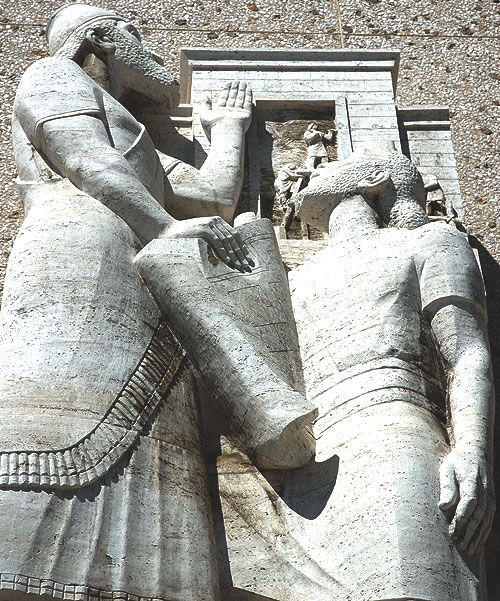 |
||||||||
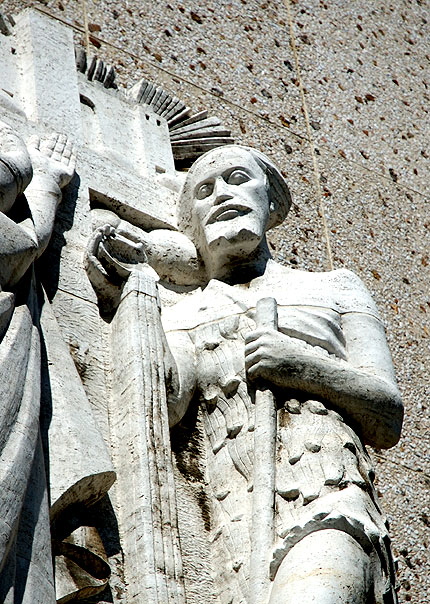 |
||||||||
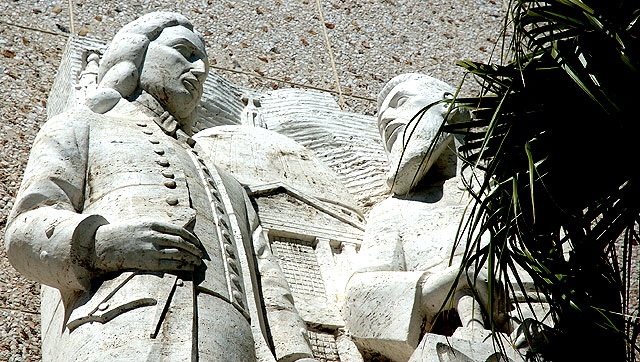 |
||||||||
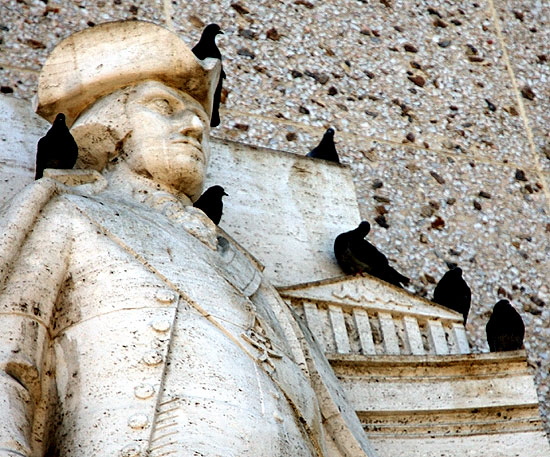 |
||||||||
|
The Eye of Providence is part of the iconography of the Freemasons. Here it represents the all-seeing eye of God, and is a reminder that a Mason's deeds are always observed by God (who is referred to in Masonry as the Great Architect of the Universe). Typically the Masonic Eye of Providence has a semi-circular glory below the eye - often the lowest rays extend further down. Sometimes the Eye is enclosed by a triangle. Other variations of the symbol can also be found with the eye itself being replaced by the letter G, representing both the art of geometry and God. The deists are still around. |
||||||||
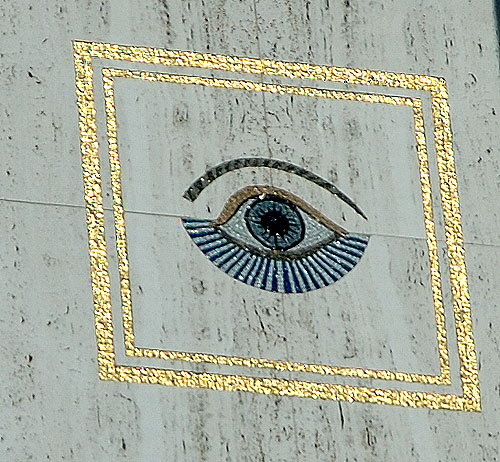 |
||||||||
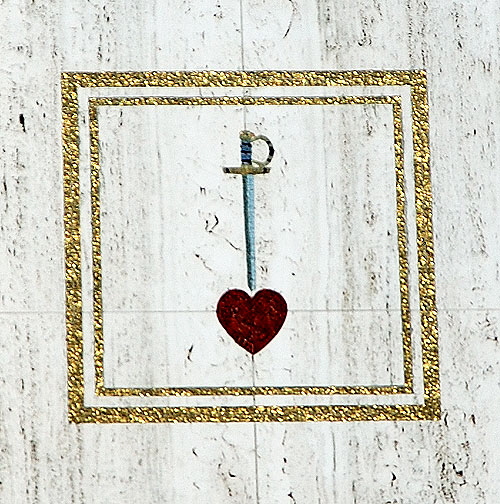 |
||||||||
|
The Scottish Rite - The Ancient and Accepted Scottish Rite, as we know it today, had its origins on the continent of Europe. Its immediate predecessor, known as The Order of the Royal Secret, consisted of 25 Degrees under the Constitutions of 1762. Masonic tradition maintains that Lodges of this Rite, transmitted from Bordeaux in France through the West Indies to the American mainland, were established at New Orleans, Louisiana, in 1763; at Albany, New York, in 1767; at Philadelphia, Pennsylvania, in 1781–82; and at Charleston, South Carolina, in 1783. The Grand Constitutions of 1786 provided for an extension of the Rite to thirty-three Degrees, governed in each country under a Supreme Council of the Thirty-third and Last Degree. Its provisions were cited in a Manifesto at Charleston that confirmed the first Supreme Council ever opened under these Grand Constitutions, on May 31, 1801, "by Brothers John Mitchell and Frederick Dalcho." All regular and recognized Supreme Councils and their Subordinate Bodies today are descended directly or collaterally from this Mother Supreme Council of the World. The Name In announcing its establishment to the Masonic world in that Manifesto, dated December 4, 1802, the name was given as The Supreme Council of the Thirty-third Degree for the United States of America. The word Scotch appeared in connection with one of the early Supreme Council Degrees, and Scotish (sic) was included in the name of one of the detached Degrees conferred by The Supreme Council. The name Ancient and Accepted Scottish Rite first appeared in an 1804 agreement between the Supreme Council of France and the Grand Orient of France. Beginning with the administration of Grand Commander Albert Pike in 1859, it came into general use in the Southern Jurisdiction and elsewhere. Many Scottish Masons fled to France during political upheavals in the 17th and 18th centuries, at a time when the Degrees of the Rite were evolving in French Freemasonry. This has caused some to think mistakenly that the Rite originated in Scotland. Actually, however, a Supreme Council for Scotland was not established until 1846. Clear? Add this - "Albert Pike's desire to establish the Scottish Rite in all parts of California led to a organizational meeting in the 'City of the Angels,' a small town of about 12,000 in 1885. December 11, 2002 - Norio Hayakawa - Freemasons Open Major Museum in Los Angeles - LOS ANGELES - A huge Masonic Museum opened its doors to the public for the first time in Los Angeles on November 26, 2002 with hardly any publicity. It is located at the Scottish Rite Masonic Temple at 4357 Wilshire Blvd., at the corner of Wilshire and "Lucerne"Street, south of "6th" Street and bounded on the east by Plymouth St. The official name of the museum is The American Heritage Masonic Museum. I had a privilege of visiting the museum on December 11, 2002. As soon as I got there, I noticed that there was a large Eye of Horus along with the G mark, the Compass, and the Beehive, and the Double-Headed Eagle adorning the western wall on Lucerne St. I also noticed a huge statue of Albert Pike encarved on the eastern wall of the building on Plymouth St. I had learned that the new tenant of the property, Morris Shaoulian had stated that the museum tells the tale of the Freemasons and their impact on American history. "This museum is not just a museum", she said. "We want all people to use and appreciate the museum. Everybody has a place here". (The building had closed its doors to the public a decade ago because of zoning issues.) The bulk of the prolific exhibits of artifacts (which include huge portraits of Albert Pike and other 33rd degree Masons) are located on the second floor. I noticed a fascinating photo of King Juan Carlos of Spain in there, as well as photos of presidents such as Harry Truman. Other items depict the Masonic affiliations of other past American presidents, from George Washington to Gerald Ford. A large library in the second floor contains tens of thousands of volumes of rare books on Freemasonry as well as books on the New Age and the occult. I was truly impressed. One can sit in the library there and it would probably take at least a whole year just to browse through volumes and volumes of those rare books. From what I am told, the 15,000 square-foot museum is the first increment in a planned 45,000 square-foot multi-purpose facility to be known in the near future as Wilshire International Pavilion. I was also impressed with the 1,800-seat theater being renovated on the first floor. The museum is open 7 days a week from 11 a.m. to 5 p.m. General admission is $5, seniors 55 and older $3 and children up to 15 $2. It was really an "illuminating" experience and perhaps some people will be "enlightened" (hopefully not frightened) in the museum. Some may be totally mystified with all types of occultic symbolisms everywhere in this museum. Whether one is pro or con on freemasonry, I would encourage everyone to visit this fascinating museum at least once. The outside will do. |
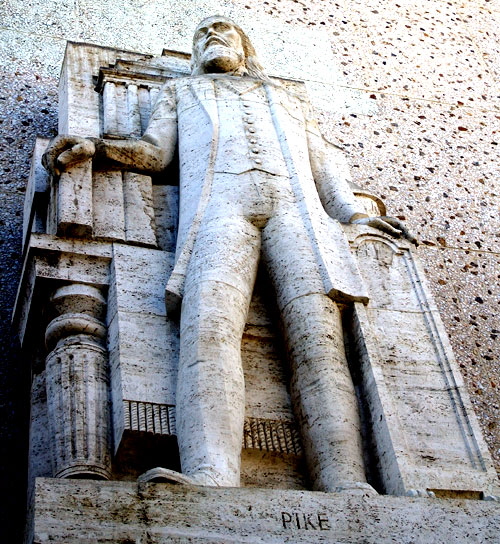 |
||
|
If you wish to use any of these photos for commercial purposes I assume you'll discuss that with me. And should you choose to download any of these images and use them invoking the 'fair use" provisions of the Copyright Act of 1976, please provide credit, and, on the web, a link back this site. Technical Note: Most of these photographs were shot with a Nikon D70 - using lens (1) AF-S Nikkor 18-70 mm 1:35-4.5G ED, or (2) AF Nikkor 70-300mm telephoto, or after 5 June 2006, (3) AF-S DX Zoom-Nikkor, 55-200 mm f/4-5.6G ED. They were modified for web posting using Adobe Photoshop 7.0. Earlier photography was done with a Sony Mavica digital still camera (MVC-FD-88) with built-in digital zoom. |
||
| [Wilshire Masons] |
|
All text and photos, unless otherwise noted, Copyright © 2003, 2004, 2005, 2006, 2007, 2008, 2009, 2010 - Alan M. Pavlik |
